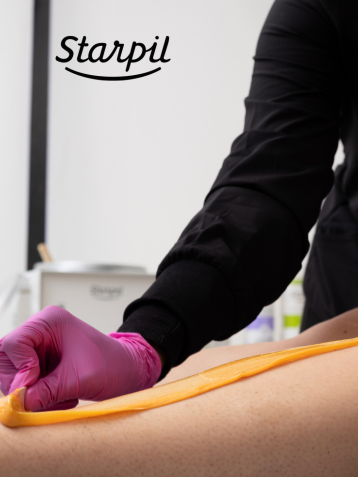Leg Waxing Duration: How Long Will It Last?
 Are you considering leg waxing but wondering how long the smooth results will last? Whether you're a beginner or thinking about trying waxing for yourself, understanding the duration of leg waxes and hair growth cycles can help you make informed decisions about your hair removal routine.
Are you considering leg waxing but wondering how long the smooth results will last? Whether you're a beginner or thinking about trying waxing for yourself, understanding the duration of leg waxes and hair growth cycles can help you make informed decisions about your hair removal routine.
In this blog, we'll explore the factors that influence how long a leg wax lasts and provide tips on spacing out your waxing sessions for optimal results.
READ: Can You Shave Between Waxing?

Hair Growth Cycles & Leg Waxing
Before diving into the duration of leg waxing, it's essential to understand how hair grows. Hair growth occurs in three phases:
-
Anagen (growth phase)
The anagen phase is the active growth period of hair. During this phase:
-
Hair follicles produce new hair cells rapidly.
-
For leg hair, the anagen phase typically lasts 30-45 days.
-
Approximately 80-90% of all hair is in the anagen phase at any given time.
-
Waxing during this phase is most effective as the hair is firmly attached to the follicle.
-
Catagen (transition phase)
The catagen phase is a short transitional period that signals the end of active hair growth:
-
Lasts about 2-3 weeks for all hair types.
-
The hair follicle shrinks and detaches from the dermal papilla.
-
The lower part of the hair stops growing but remains firmly planted in the follicle.
-
Telogen (resting phase)
The telogen phase is the resting period of the hair growth cycle:
-
Lasts about 3-4 months for body hair.
-
Old hair remains in place until it's pushed out by new growth.
-
Towards the end of this phase, the follicle will re-enter the anagen phase.
-
Waxing during the telogen phase is less effective, as the hair is more likely to break rather than be pulled out from the root.
Your leg hair is in various stages of this cycle at any given time. Waxing is most effective during the anagen phase when the hair is actively growing and firmly attached to the follicle.
READ: Waxing 101: Which Direction Should You Pull the Wax?

How Long Does a Leg Wax Typically Last?
On average, a leg wax can last anywhere from 3 to 6 weeks. However, this duration can vary depending on several factors:
-
Individual hair growth rate
-
Hair thickness and texture
-
Hormonal changes
-
Diet and lifestyle
-
Waxing technique and quality
For most people, noticeable regrowth begins around the 3-week mark. However, the hair that grows back is often finer and sparser than before, making it less noticeable. Waxing regularly can also lead to finer, sparser hair growth over time.
READ: Exfoliation After Waxing: When and How to Do It Right
Factors Affecting Leg Wax Duration
1. Hair Growth Rate
Everyone's hair grows at different rates. Some people may experience faster regrowth, while others may enjoy longer-lasting results. Genetics plays a significant role in determining your hair growth rate.
2. Hair Thickness and Texture
Coarser, thicker hair tends to be more noticeable when it grows back compared to fine, light hair. If you have thicker hair, you might feel the need to wax more frequently.
3. Hormonal Changes
Hormonal fluctuations due to menstrual cycles, pregnancy, or medical conditions can affect hair growth. You might notice that your waxing results last longer or shorter during different times of the month or during significant life changes.
4. Diet and Lifestyle
Your diet and overall health can impact hair growth. A balanced diet rich in vitamins and minerals can promote healthy hair growth, potentially affecting how quickly your hair returns after waxing.
5. Waxing Technique and Quality
The quality of your wax and the technique used can significantly impact how long your results last. Professional waxing often yields longer-lasting results due to the expertise of the esthetician and the quality of products used.
READ: Waxing vs. Shaving: What is the Best Method for Hair Removal?

How to Space Out Leg Waxing Sessions
To maintain smooth legs and optimize your waxing routine, it's important to time your sessions correctly. Here are some guidelines for spacing out your leg waxing appointments, whether you're visiting a professional or waxing at home:
Professional Waxing Appointments
For those who visit prefer professional waxing:
-
Initial appointments: Schedule your first few appointments 3-4 weeks apart. This allows your esthetician to catch hairs in different growth cycles and helps train your hair to grow more uniformly.
-
Maintenance appointments: Once you've established a routine, you can typically space out appointments every 4-6 weeks, depending on your hair growth rate.
-
Seasonal considerations: Always keep a consistent schedule regardless of season in order to keep your hair growth uniform and results consistent.
-
Special events: If you have a special event coming up, book your appointment 3-5 days in advance to allow any potential irritation to subside.
Independent Waxing Sessions
If you're waxing at home:
-
Start with a 3-4 week schedule: Begin by waxing every 3-4 weeks to catch hairs in different growth phases.
-
Adjust based on results: Pay attention to how quickly your hair grows back and adjust your schedule accordingly. Some areas might need more frequent attention than others.
-
Be consistent: Regular waxing can lead to finer, sparser hair growth over time. Try to maintain a consistent schedule for best results.
-
Allow for proper hair length: Ensure your hair is about 1/4 inch long before waxing. This usually takes about 2-3 weeks of growth for most people.
READ: Waxing at Home: The Complete Beginner’s Guide

Tips for Longer-Lasting Waxing Results
To extend the smooth results of your leg wax:
-
Exfoliate regularly: Gentle exfoliation helps prevent ingrown hairs and promotes even hair growth. Use an Ingrown Hair Serum 24 hours after waxing to prevent ingrowns.
-
Moisturize: Keep your skin hydrated to maintain its health and appearance between waxes.
-
Pre & post wax care: Always perform proper pre & post-wax care procedures before and after waxing to ensure your skin and results are at their best.
-
Avoid shaving between waxes: Shaving can disrupt the hair growth cycle and make your next waxing session less effective.
-
Be patient: It may take several waxing sessions to see a noticeable reduction in hair growth and extended smoothness.
READ: Your Complete Guide to Roll-On Waxing

Final Thoughts
Remember, everyone's hair growth is unique. It may take some time to find the perfect waxing schedule that works for you. Whether you choose professional services or decide to wax on your own, consistency is key to achieving longer-lasting, smoother results.
By understanding your hair growth cycle and following these guidelines, you can enjoy the benefits of leg waxing while minimizing regrowth and maintaining silky smooth skin for weeks at a time.





Comments